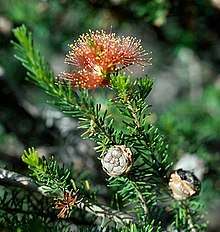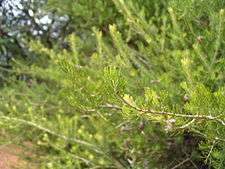Eremaea ebracteata
Eremaea ebracteata is a plant in the myrtle family, Myrtaceae and is endemic to the south-west of Western Australia. It is a shrub with narrow, mostly linear leaves and which bears orange-coloured flowers on the long branches of the same season's growth. The fruits have a surface that is rough and lumpy.
| Eremaea ebracteata | |
|---|---|
 | |
| Eremaea ebracteata in Kings Park, Perth | |
| Scientific classification | |
| Kingdom: | Plantae |
| Clade: | Tracheophytes |
| Clade: | Angiosperms |
| Clade: | Eudicots |
| Clade: | Rosids |
| Order: | Myrtales |
| Family: | Myrtaceae |
| Genus: | Eremaea |
| Species: | E. ebracteata |
| Binomial name | |
| Eremaea ebracteata | |
| Synonyms | |
Description
Eremaea ebracteata is a shrub which grows to a height of about 1.0 metre (3 ft) and which has its younger branches densely covered with fine hairs. The leaves are linear to broad egg-shaped with the narrower end towards to base, 2.5–8.2 millimetres (0.1–0.3 in) long, 0.5–1.7 millimetres (0.02–0.07 in) wide and have a single prominent vein visible on the lower surface. (The two varieties differ mainly in leaf size and shape.)[1]
The flowers are orange and are on the ends of long branches which grew earlier in the same season. The flowers occur singly, rarely two or three together. There are 5 sepals which are hairy on the outside surface and 5 petals 5.4–6.7 millimetres (0.2–0.3 in) long. The stamens are arranged in 5 bundles, each containing 40 to 60 stamens. Flowering occurs from November to December and is followed by fruits which are woody capsules. The capsules are 5.8–8.4 millimetres (0.2–0.3 in) long, 5.7–9.5 millimetres (0.2–0.4 in) long, cup shaped to almost spherical and are rough or lumpy on the outer surface.[1]

Taxonomy and naming
Eremaea ebracteata was first formally described in 1860 by Ferdinand von Mueller in Fragmenta Phytographiae Australiae.[2][3] The specific epithet (ebracteata) is from the Latin prefix e meaning "without"[4]:562 and bracteatus meaning "gilt".[4]:372 >
There are two varieties:
- Eremaea ebracteata F.Muell. var. ebracteata has linear leaves 4.5–8.2 millimetres (0.2–0.3 in) long, 0.5–1.0 millimetre (0.02–0.04 in) wide;
- Eremaea ebracteata var. brachyphylla Hnatiuk has elliptic or egg-shaped leaves 2.5–3.1 millimetres (0.098–0.12 in) long, 1.3–1.7 millimetres (0.05–0.07 in) wide.
Distribution and habitat
Eremaea ebracteata is found in the Irwin district although var. ebracteata generally occurs in more northern parts of the range. It grows in sand or sandy loam on sandplains.[5][6]
Conservation
Both varieties of Eremaea ebracteata are classified as "not threatened" by the Western Australian Government Department of Parks and Wildlife.[5]
References
- Hnatiuk, Roger J. (1998). "A revision of the genus Eremaea (Myrtaceae)" (PDF). Nuytsia. 9 (2): 190–194. Retrieved 8 August 2015.
- von Mueller, Ferdinand (1860). Fragmenta Phytographiae Australiae (Volume 2). Melbourne. pp. 29–30. Retrieved 11 August 2015.
- "Eremaea ebracteata". APNI. Retrieved 11 August 2015.
- Brown, Roland Wilbur (1956). The Composition of Scientific Words. Washington, D.C.: Smithsonian Institution Press.
- "Eremaea ebracteata". FloraBase. Retrieved 11 August 2015.
- Paczkowska, Grazyna; Chapman, Alex R. (2000). The Western Australian flora : a descriptive catalogue. Perth: Wildflower Society of Western Australia. p. 362. ISBN 0646402439.